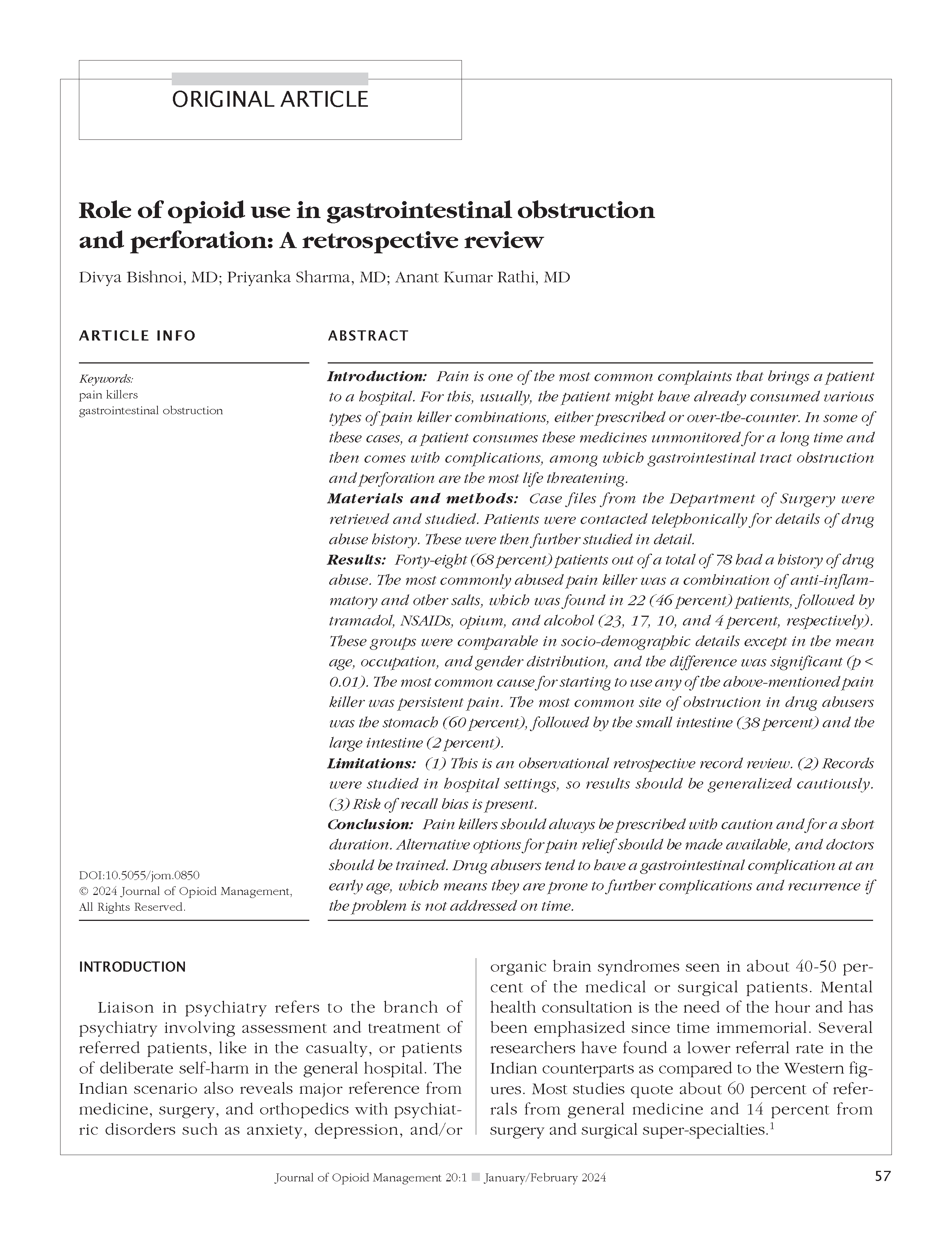Role of opioid use in gastrointestinal obstruction and perforation: A retrospective review
DOI:
https://doi.org/10.5055/jom.0850Keywords:
pain killers, gastrointestinal obstructionAbstract
Introduction: Pain is one of the most common complaints that brings a patient to a hospital. For this, usually, the patient might have already consumed various types of pain killer combinations, either prescribed or over-the-counter. In some of these cases, a patient consumes these medicines unmonitored for a long time and then comes with complications, among which gastrointestinal tract obstruction and perforation are the most life threatening.
Materials and methods: Case files from the Department of Surgery were retrieved and studied. Patients were contacted telephonically for details of drug abuse history. These were then further studied in detail.
Results: Forty-eight (68 percent) patients out of a total of 78 had a history of drug abuse. The most commonly abused pain killer was a combination of anti-inflammatory and other salts, which was found in 22 (46 percent) patients, followed by tramadol, NSAIDs, opium, and alcohol (23, 17, 10, and 4 percent, respectively). These groups were comparable in socio-demographic details except in the mean age, occupation, and gender distribution, and the difference was significant (p < 0.01). The most common cause for starting to use any of the above-mentioned pain killer was persistent pain. The most common site of obstruction in drug abusers was the stomach (60 percent), followed by the small intestine (38 percent) and the large intestine (2 percent).
Limitations: (1) This is an observational retrospective record review. (2) Records were studied in hospital settings, so results should be generalized cautiously. (3) Risk of recall bias is present.
Conclusion: Pain killers should always be prescribed with caution and for a short duration. Alternative options for pain relief should be made available, and doctors should be trained. Drug abusers tend to have a gastrointestinal complication at an early age, which means they are prone to further complications and recurrence if the problem is not addressed on time.
References
Jindal RC, Hemrajani DK: A study of psychiatric referrals in a general hospital. Indian J Psychiatry. 1980; 22(1): 108-110.
Ambekar A, Agarwal A, Rao R, et al.: Chadda RK on behalf of the group of investigators for the National Survey on the Extent and Pattern of Substance Use in India. In Magnitude of Substance Abuse in India. New Delhi: Ministry of Social Justice and Empowerment, Government of India, 2019.
Saxena AK, Jain PN, Bhatnagar S: The prevalence of chronic pain among adults in India. Indian J Palliat Care. 2018; 24(4): 472-477. DOI: 10.4103/IJPC_141_18. DOI: https://doi.org/10.4103/IJPC.IJPC_141_18
Camilleri M, Lembo A, Katzka DA: Opioids in gastroenterology: Treating adverse effects and creating therapeutic benefits. Clin Gastroenterol Hepatol. 2017; 15(9): 1338-1349. DOI: 10.1016/j.cgh.2017.05.014. DOI: https://doi.org/10.1016/j.cgh.2017.05.014
Tørring ML, Riis A, Christensen S, et al.: Perforated peptic ulcer and short-term mortality among tramadol users. Br J Clin Pharmacol. 2008; 65(4): 565-572. DOI: 10.1111/j.1365-2125.2007.03038.x. DOI: https://doi.org/10.1111/j.1365-2125.2007.03038.x
Hána L, Ryska M: Acute abdomen in drug abusers. Rozhl Chir. 2019; 98(1): 14-17.
Siddiqui HY: Drug Abuse Monitoring System: A Profile of Treatment Seekers. Ministry of Social Justice and Empowerment, Government of India and United Nations Office on Drugs and Crime, Regional Office for South Asia. Available at https://www.unodc.org/pdf/india/DAMS%20Monograph.pdf. Accessed November 14, 2023.
Sarkar S, Nebhinani N, Singh SM, et al.: Tramadol dependence: A case series from India. Indian J Psychol Med. 2012; 34: 283-285. DOI: 10.4103/0253-7176.106038. DOI: https://doi.org/10.4103/0253-7176.106038
Goldstein JL, Cryer B: Gastrointestinal injury associated with NSAID use: A case study and review of risk factors and preventative strategies. Drug Healthc Patient Saf. 2015; 7: 31-41. DOI: 10.2147/dhps.s71976. DOI: https://doi.org/10.2147/DHPS.S71976

Published
How to Cite
Issue
Section
License
Copyright 2005-2025, Weston Medical Publishing, LLC and Journal of Opioid Management. All Rights Reserved.










